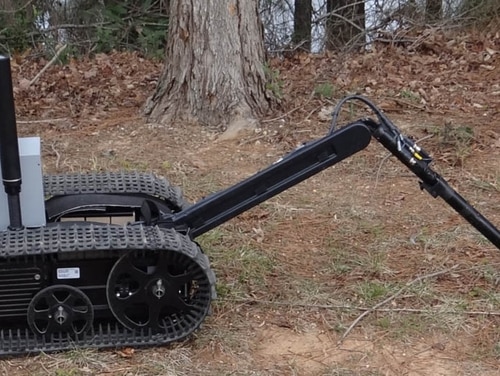Soldiers tasked with breaching a minefield or similar obstacle now rely on state of the art equipment and techniques — from the 1950s.
The Army aims to get those humans out of one of the most dangerous battlefield scenarios through a combination of better ways to neutralize mines or obstacles, better detection of said mines or obstacles, and robots to do the job.
Early versions of this are underway in some testing scenarios but likely won’t hit deploying units until 2028. And a full-fledged solution isn’t expected until 2035, according to a panel at this year’s Association of the U.S. Army conference.

Army engineers, along with technology centers for ammunition, night vision and sensors, are tackling this thorny problem.
The 2028 timeline would add semi-autonomous machines to the kit, while also improving detection, neutralization, fire control and munitions for engineers encountering these complex problems.
The 2035 solution would combine air and ground autonomous platforms to essentially do the job for soldiers.
And this planning isn’t for a one-off, rare occurrence.
“The more you distribute a force in our multi-domain operations concepts, the more likely you are to have to do breach missions as adversaries respond to this construct,” said Maj. Gen. David Hill, deputy commanding general, U.S. Army Corps of Engineers Command.
Get all the news from the 2020 AUSA annual meeting.
That’s because as units disperse, adversaries will want to rapidly deploy minefields or other such obstacles to isolate and channel the attackers, such as a battalion or even brigade formation on the move.
Running into a minefield creates a choke point while also stalling the advance. That creates time for targeting and precision long range fires to take effect.
Earlier this year, the Army ran a platoon-size robotic wingman breach, remotely controlling a vehicle from cover at a distance.
Army researchers used upgraded Bradleys, dubbed Mission Enabler Technologies-Demonstrators, or MET-Ds. Those upgrades include a remote turret for the 25mm main gun, 360-degree awareness cameras and enhanced crew stations with touchscreens
Right now, human soldiers in infantry units employ a Bangalore torpedo, a handheld, tube-section charge that allows them to snake an explosive, one section at a time, through an obstacle to blow it and create a path.
The automated, longer range options are essentially mechanized versions of this that have been around since the 1970s. Soldiers launch a string of explosives through the air that lands on the obstacle and is denotated quite close, as much as 100 yards, from the impediment.
This just won’t do in an area of ever-present drone coverage and precision fire on all sides.
Once blown through, a human engineer team marks the obstacle with signs and flags so the next unit can find its way through the treacherous territory.
But in recent years, more attention has been given to the development of smart mines that can move themselves around the battlefield and reconfigure. If an adversary has this technology, it would render lane marking useless. In fact, the markings could make the situation even more dangerous by giving a false sense of security to oncoming friendly forces.
The Army’s efforts to address all these battlefield problems also apply to other methods of maneuver and threats, such as asymmetric improvised explosive devices in common use for the past two decades. Breaching and route clearance also mimic wet gap crossing, Brig. Gen. Mark Quander noted.
“In both cases we’ve got to try and figure out, ‘How do we sense and detect where the obstacle’s at?’” Quander said.
That means better sensors and better ways of getting that data to the right place at the right time.
That means better aided target recognition and machine learning, said Michael Grove, principal deputy for technology and countermine night vision and electronic sensors at the Army’s Communications-Electronics, Research and Engineering Center.
Adding artificial intelligence into the mix will help find the obstacles when, or before, they’re reached, giving commanders more options on how to avoid or handle them.